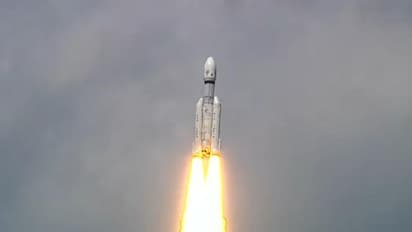Chandrayaan-3 sets off on lunar odyssey; ISRO's LVM3 successfully inducts it into orbit | WATCH

Synopsis
Chandrayaan-3, developed by ISRO, consists of a lander, propulsion module, and rover, with the primary objective of achieving a safe landing on the lunar surface. Its mission includes gathering data and conducting various scientific experiments to enhance our understanding of the moon's composition.
The Indian Space Research Organisation's (ISRO) Chandrayaan-3 mission successfully takes off from the Satish Dhawan Space Centre in Sriharikota, Andhra Pradesh, at 2.35 PM IST on Friday, July 14. The mission follows Chandrayaan-2 where scientists aim to demonstrate various capabilities including reaching the orbit of the moon, making a soft-landing on the lunar surface using a lander, and a rover coming out of the lander to study the surface of the moon.
Watch the video here:
Chandrayaan-3: Nine crucial steps before LVM3 lift-off
The 43.5-metre tall rocket LVM 3 weighing 642 tons executed three-stage maneuvres before separating Chandrayaan 3 just 16 minutes after taking off from Sriharikota.
Chandrayaan-3 was inserted into the Lunar Transfer Trajectory after the orbit-raising manoeuvres. Covering over 300,000 km, Chandrayaan will reach the Moon in the coming weeks. Scientific instruments onboard will study the Moon’s surface and enhance our knowledge.
Chandrayaan-3 will travel in an elliptical path to reach the surface of the moon for thirty days. The lunar mission is divided into three phases- the earth-centric phase, the Lunar Transfer Phase and the Moon Centric Phase.
Prime Minister Narendra Modi extended his wishes to the ISRO team and said, "Chandrayaan-3 scripts a new chapter in India's space odyssey. It soars high, elevating the dreams and ambitions of a every Indian. This momentous achievement is a testament to our scientists' relentless dedication. I salute their spirit and ingenuity!"
This mission aims to achieve a controlled landing on the moon. If successful, India will join the exclusive club of only four countries that have accomplished this feat. With a modest budget of approximately $75 million.
This marks India's second endeavour towards a soft landing, following the unsuccessful Chandrayaan-2 mission in 2019. In 2008, their initial lunar probe, Chandrayaan-1, successfully orbited the moon before deliberately crash-landing on its surface.
Chandrayaan-3: How ISRO decided on launch window of 2:35 pm
The lander is expected to make a soft landing and the rover will conduct the experiments on the lunar surface. The life of the payload carried by the propulsion module post-ejection of the lander is between three and six months.
The mission life of the lander and the rover is 1 Lunar day or 14 Earth days. The mission is to study Earth from lunar orbit and to measure the near-surface and its density changes.
The mission is also to carry out measurements of the thermal properties of the lunar surface near the polar region and look out for lunar seismic activity around the landing site and delineate the structure of the lunar crust and mantle.
Chandrayaan-3, developed by ISRO, consists of a lander, propulsion module, and rover, with the primary objective of achieving a safe landing on the lunar surface. Its mission includes gathering data and conducting various scientific experiments to enhance our understanding of the moon's composition.
Soft-landing a spacecraft on the moon's surface is a complex endeavour accomplished by only three other nations: the United States, Russia, and China.
Stay updated with the Breaking News Today and Latest News from across India and around the world. Get real-time updates, in-depth analysis, and comprehensive coverage of India News, World News, Indian Defence News, Kerala News, and Karnataka News. From politics to current affairs, follow every major story as it unfolds. Get real-time updates from IMD on major cities weather forecasts, including Rain alerts, Cyclone warnings, and temperature trends. Download the Asianet News Official App from the Android Play Store and iPhone App Store for accurate and timely news updates anytime, anywhere.